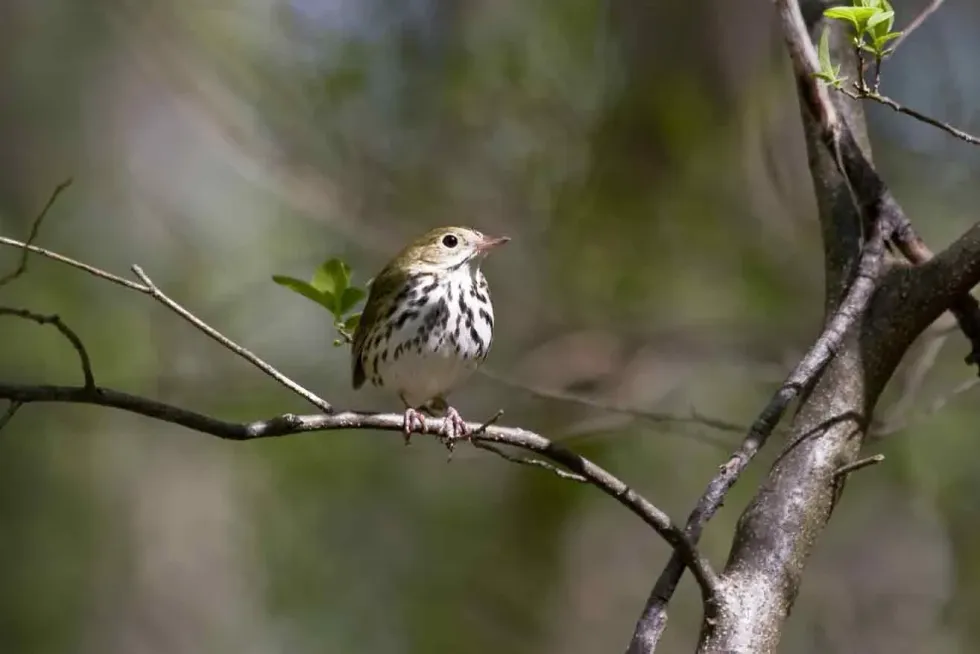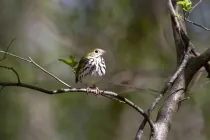Ovenbirds belong to the Aves class of the Parulidae family. These tiny yet adorable birds are very migratory. They usually tend to migrate from place to place in different seasons. Ovenbirds originated from North America, and they usually shift to mid-America during winters.
They can fly up to 64km/h in the night when they shift to a summer home. Ovenbirds are oval with olive green, brown, orange stripes and pink legs, enhancing the beauty of the species. They are commonly known as wood-warblers with around 236 species.
If you find this article interesting, do check our articles on hawk or shoebill.
Ovenbird Interesting Facts
What type of animal is an Ovenbird?
Ovenbirds are North American birds related to the Warbler from the Parulidae family. This bird is famously referred to as the migratory bird that breeds in eastern North America. They shift to Central America, many Caribbean islands, Florida, and northern Venezuela during wintering grounds. Ovenbirds spend most of their time in migration.
What class of animal does an Ovenbird belong to?
Of the order Passeriformes, the Ovenbird is one of the North American birds that belong to the Aves class with the scientific name Seiurus aurocapilla. They are wood-warblers and omnivores who usually migrate to the lowlands during winter.
How many Ovenbirds are there in the world?
There is no specific number given regarding the total population of Ovenbirds. This bird conservation is 'Least Concern' and is usually found in North America in more significant numbers. There are a total of 55 genera of ovenbird Seiurus Aurocapilla and around 236 species. They are also known as the Songbird.
Where does an Ovenbird live?
Wood warblers, of order Passeriformes family, choose rocky intertidal zones, dense and deciduous forests, desert, and high alpine areas for living and for survival. This bird usually constructs its nest on the ground. The Ovenbird's nest is what differentiates it from most other birds.
What is an Ovenbird's habitat?
Ovenbirds love migrating and shifting to parts of Central America with other warblers. Ovenbirds are generally spotted in mature deciduous or mixed broadleaf-conifer forests and sometimes on pine forests.
They construct their own nest on the ground, also known as a domed Ovenbird nest, which has a side entrance. The female bird takes five days for the overall construction of the nest. Warblers adapt differently as per the different seasons.
Who do Ovenbirds live with?
Ovenbirds hop and fly in groups but tend to walk alone on the forest floor among the leaf litter while shaking their tails and wobbling their heads. They don't usually live in groups, but there are certain activities that they perform in groups.
They don't panic or blush when they get approached. Instead, they remain stable and silent on the forest floor.
These birds make their own domed nest on the ground and usually tend to sing a song to communicate or keep themselves entertained, hence the name 'warbler'. Male birds go by themselves into forests, searching for food for female birds and young ones.
How long does an Ovenbird live?
The nature of the Ovenbird is migratory, and it adapts differently according to the changing seasons. The life span of warblers is 132 months when they live in the wild. They are wild birds and are generally spotted on the forest floor. The annual adult survival is about 71 percent on average.
How do they reproduce?
Every species of bird has its own and unique way of reproduction. The Ovenbird requires larger adjacent areas for breeding. The male bird chases a female bird in a wild courting flight.
The breeding takes place in late March and early May. The female bird constructs her own nest on the floor of deciduous woods or above the ground in low plants or shrubs.
The nest is usually shaped like a Dutch oven on the forest floor with a side entrance. The female species incubate the eggs, and they stay on the breeding grounds until the hatchlings become ready to protect themselves. Eggs are two cm long with brown and grey markings on them.
What is their conservation status?
According to IUCN, the conservation status of the Ovenbirds is of Least Concern. Hence we need not worry about their conservation.
Ovenbird Fun Facts
What do Ovenbirds look like?
Ovenbirds are one of the dark-colored species. They are usually found in areas of North America and Central America during winters. They live in rocky intertidal zones to deciduous forests, deserts, and high alpine regions. These birds are oval and look similar to sparrows.
They are olive green with bold black-and-orange crown stripes. The most adorable feature of this bird is its eyes, they come with a white eye-ring. Warblers have pink legs and yellowish feathers.
How cute are they?
Ovenbirds are extremely cute and adorable. They have cute pink legs, which enhance the beauty of the species. They are oval with attractive black and orange stripes on them.
The cutest thing about this species is its nest. They build oval shape nests, usually on the ground in the habitat of forest areas. Ovenbirds get their name because they build nests that look like a Dutch oven.
How do they communicate?
The Ovenbird call is fairly simple and composed of buzzy notes of varying speeds that rise and fall in pitch. Their sound is sometimes unmusical and harsh. They use different sounds while communicating. They also have a different voice, song, and pitch during breeding seasons to call out to their mating partners in their habitat.
How big is an Ovenbird?
Ovenbirds are large wood-warblers that weigh about 0.67 oz (19 g) and 4.3–6.3 in (11–16 cm) long. Their wingspan is about 7.5–10.2 in (19–26 cm). They are slightly smaller than sparrows.
How fast can an Ovenbird fly?
This species can fly up to 64km/h when they migrate at night to their summer home. Being one of the few birds that live in the forest during winters, they build their nests right there.
How much does an Ovenbird weigh?
They weigh around 0.67 oz (19 gm) on average. Their weight could fall anywhere between the range of 0.49–1.02 oz (14–28.8 gm).
What are their male and female names of the species?
There is no specific name given for male and female species. The males are known as male ovenbirds, and the females are known as female ovenbirds.
What would you call a baby Ovenbird?
There is no specific name given for the babies, but they are usually known as chicks like most other baby birds.
What do they eat?
They are omnivores and eat insects and small amphibians. They also eat forest insects and other invertebrates: a range of adult beetles and larvae, ants, caterpillars, flies, and other insects. They also consume seeds occasionally.
Are they dangerous?
They are not a dangerous bird. Have you seen how cute and petite they are? They are wild birds and live in the forest habitat but are not dangerous to humans.
Would they make a good pet?
They don't usually make good pets because they prefer living in forests. They also build a domed nest on the forest floors and would not adapt well to human-made environments.
Did you know...
During the breeding season, both the partners are equally responsible for defending their territories. Sometimes the brown-headed birds put their eggs in the homes of Ovenbirds. The Ovenbird fails to recognize them and ends up losing its offspring.
They sing a song for communication. It is stunning to listen to.
Their common predators are snakes, blue jays, owls, squirrels, raccoons, skunks, weasels, and chipmunks.
They walk alone amidst the leaf litter. Some even call them dramatic for doing so!
The Ovenbird's call
Both males and females share a call or song generally used for communication between them and while chasing animals or birds or while defending their territory.
How did the Ovenbird get its name?
They got their name from the covered nest which females construct out of twigs and leaf litter. This is said to look like a Dutch oven.
The bird has other names, too, such as Motacilla Aurocapilla Linnaeus and the scientific name Seiurus aurocapillus.
Here at Kidadl, we have carefully created lots of interesting family-friendly animal facts for everyone to discover! Learn more about some other birds, including owl or house wren.
You can even occupy yourself at home by drawing one on our Ovenbird coloring pages.










